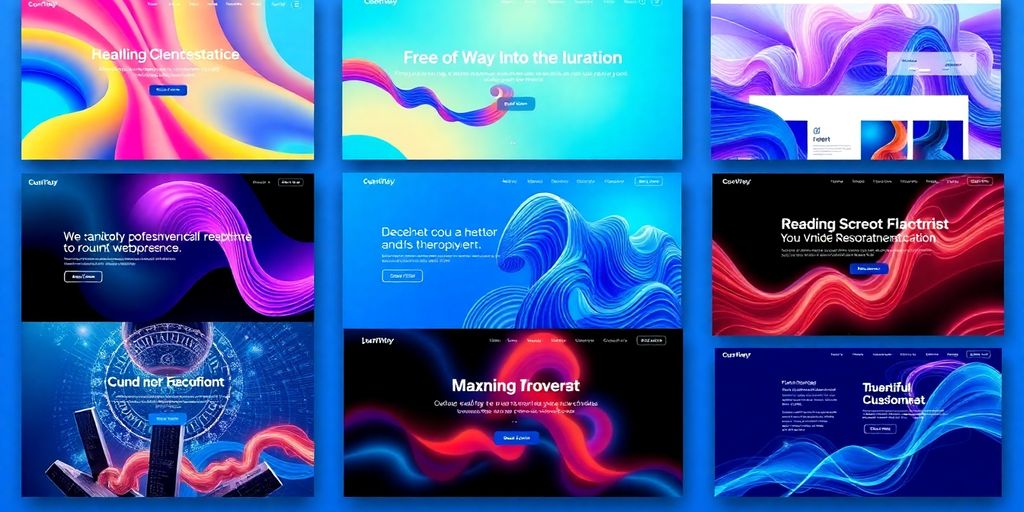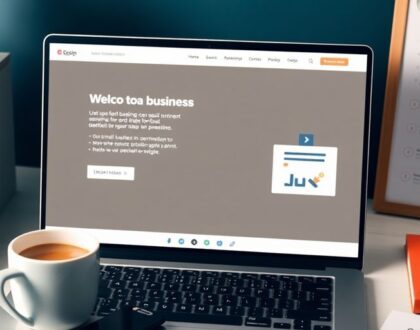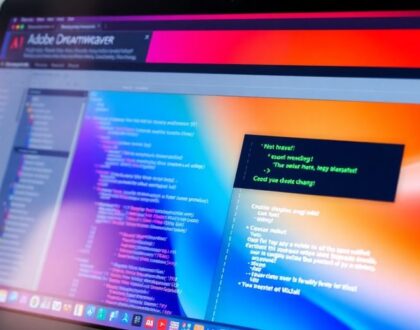Discover the Best Website Design Websites for Stunning Inspiration in 2025

In 2025, web design is all about creativity and innovation. Whether you’re just browsing for fun or looking to build your own site, there’s a world of inspiration out there. From minimalist designs to interactive user experiences, the trends are diverse and exciting. This article dives into some of the best website design websites to spark your imagination and guide you in creating stunning web pages.
Key Takeaways
- Minimalist designs are still in vogue, emphasizing clean lines and simplicity.
- Dark mode is gaining traction, offering a sleek and modern look.
- Interactive elements are key for keeping users engaged and enhancing the experience.
- Platforms like Awwwards, Behance, and Dribbble are top spots for web design inspiration.
- Award-winning websites often set trends and influence future design directions.
Exploring Innovative Web Design Trends

Minimalist Aesthetics in Modern Web Design
Minimalism is more than just a design choice; it’s a lifestyle that has seeped into the digital world. Simplicity and clarity are the core tenets of minimalist web design. This approach strips away the unnecessary, leaving only essential elements that communicate the brand’s message effectively. The use of generous white space, limited color palettes, and clean typography are hallmarks of this style. Designers are increasingly opting for this approach to create intuitive and user-friendly experiences that don’t overwhelm visitors.
The Rise of Dark Mode in Web Design
Dark mode isn’t just a trend; it’s becoming a staple feature in modern web design. This feature offers several advantages, such as reducing eye strain and saving battery life on OLED screens. It also provides a sleek and modern look that many users find appealing. The contrast between the dark background and bright text can make content pop, creating a striking visual effect. As more people prefer dark mode, it’s becoming crucial for designers to offer this option to improve user satisfaction.
Interactive Elements for Engaging User Experience
Incorporating interactive elements is a surefire way to enhance user engagement on a website. These elements can range from simple hover effects to complex animations that respond to user input. Interactive design not only captivates users but also encourages them to explore more content. It transforms a static browsing experience into a dynamic journey, making the website more memorable. With advancements in technology, designers have a plethora of tools at their disposal to create these engaging experiences, ensuring that users are not just passive viewers but active participants in their digital journey.
As we move forward, the fusion of aesthetics and functionality will define the future of web design. Embracing these innovative trends will not only keep your website relevant but also ensure it provides a compelling user experience.
For more insights on web design tools for 2025, check out our comprehensive guide that explores the latest trends and technologies shaping the future of web design.
Top Platforms for Web Design Inspiration
Awwwards: Celebrating Design Excellence
Awwwards is a standout platform that recognizes and promotes exceptional web design. It’s a place where designers can submit their work to be reviewed by a panel of experts. The platform awards the best designs, providing an excellent source of inspiration for anyone looking to elevate their web design skills. With its focus on innovation and creativity, Awwwards has become a go-to for designers seeking to push the boundaries of what’s possible on the web.
- Daily inspiration from award-winning designs.
- Community voting and expert reviews.
- Trends and insights from top designers.
Behance: A Hub for Creative Professionals
Behance is a vibrant online platform where creative professionals from all over the world showcase their work. It’s a treasure trove of ideas, featuring everything from graphic design to photography and, of course, web design. Behance’s vast collection of projects makes it easy to find inspiration for any kind of design project. The platform also allows designers to connect, share feedback, and collaborate, fostering a community of creativity.
- Discover projects by top designers and artists.
- Follow your favorite creators for updates.
- Engage with a global community of creatives.
Dribbble: Showcasing Innovative UI/UX Designs
Dribbble is well-known for showcasing innovative UI and UX designs. It’s a community-driven platform where designers share their latest projects, ranging from web interfaces to mobile app designs. Dribbble’s focus on user interface and experience design makes it an essential resource for anyone looking to improve their UI/UX skills. The platform is also a great place to get feedback and connect with other designers.
- Explore cutting-edge UI/UX design trends.
- Share and receive feedback on your designs.
- Network with professionals in the design industry.
Whether you’re redesigning an effective web page or starting from scratch, these platforms provide a wealth of inspiration and resources to help you create visually appealing and functional designs.
Award-Winning Websites to Watch
The Impact of Awwwards on Web Design
Awwwards has played a huge role in shaping the landscape of web design. Their recognition of creative excellence has set benchmarks for designers worldwide. Winning an Awwwards title can catapult a website into the spotlight, encouraging innovative approaches and pushing the boundaries of what’s possible online. Sites like Dopple Press have been featured for their exceptional user experience, inspiring countless designers to rethink how they approach UX.
Notable Winners from Recent Years
Over the years, several websites have stood out for their creativity and functionality. Here’s a quick look at some notable winners:
- Alan Menken’s Portfolio: This site captures the essence of his musical journey with a minimalist design and interactive elements that make you feel like you’re part of his world.
- Crypton.Trading: Known for its innovative use of AI and animation, this site offers a unique way to explore cryptocurrency trends.
- 1917: In the Trenches: A fully immersive experience that lets users explore the film’s sets in 360-degree AR, bringing the movie’s atmosphere to life.
How Awards Influence Design Trends
Awards like those from Awwwards often set the stage for emerging trends in web design. When a site wins, it becomes a reference point for others, sparking new ideas and influencing the direction of future projects. For instance, the rise of dark mode and interactive storytelling can be traced back to award-winning sites that dared to try something different. These sites not only showcase the latest in design but also challenge others to innovate and elevate the user experience.
Designing for User Experience and Accessibility
Key Principles of User-Centric Design
Creating a website that users love involves more than just pretty visuals. It’s about understanding what users need and how they interact with your site. Here are a few key principles:
- Simplicity: Keep the design clean and easy to navigate. Users should find what they’re looking for without hassle.
- Consistency: Use familiar layouts and elements so users feel comfortable and know what to expect.
- Feedback: Provide clear feedback for user actions, like button clicks or form submissions, so they know what’s happening.
Designing with the user in mind means thinking about their journey and ensuring every step is smooth and intuitive.
Incorporating Accessibility in Web Design
Accessibility isn’t just a buzzword; it’s a necessity. Making your site usable for everyone, including those with disabilities, is crucial. Consider these aspects:
- Alt Text: Use descriptive alt text for images to aid screen readers.
- Keyboard Navigation: Ensure all functionalities are accessible via keyboard for users who can’t use a mouse.
- Color Contrast: High contrast between text and background helps users with visual impairments.
Balancing Aesthetics and Functionality
While aesthetics are important, they shouldn’t overshadow functionality. A beautiful site that’s hard to use won’t keep visitors around. Here’s how to balance the two:
- Prioritize Content: Make sure the main content is easy to find and read.
- Responsive Design: Use layouts that adjust smoothly across devices, enhancing both look and usability.
- Test and Iterate: Regularly test your site with real users and tweak based on feedback.
Building a premium website means combining stunning visuals with seamless user experience. It’s about creating a digital space that’s both engaging and accessible.
Leveraging Technology in Web Design
AI and Machine Learning in Web Design
AI and machine learning are changing the web design landscape. These technologies are not just buzzwords; they’re actively being used to personalize user experiences. Imagine a website that adjusts its layout based on the user’s previous interactions. That’s the power of AI! Machine learning algorithms analyze user behavior, allowing websites to suggest content or products that the user might find interesting. This isn’t just cool tech—it’s a way to keep users engaged and coming back for more.
The Role of Responsive Design
Responsive design is no longer optional; it’s a must. With the rise in mobile device usage, websites need to look good on every screen size. A responsive design ensures that your site is accessible and functional, whether viewed on a smartphone, tablet, or desktop. This adaptability not only improves user experience but also boosts your site’s SEO ranking. So, if your site isn’t yet responsive, it’s high time to make that change.
Future-Proofing Your Website with Technology
Future-proofing your website means preparing it for the tech advancements of tomorrow. This involves using scalable frameworks and keeping your design flexible. The goal is to make updates and improvements easy as new technologies emerge. Consider integrating website design portfolio templates to maintain a modern look while saving time. These templates offer a foundation that’s easy to update as trends change. Keep an eye on tech trends and be ready to adapt to keep your site fresh and relevant.
Technology in web design is not just about keeping up with trends; it’s about creating a site that evolves with your audience’s needs. Staying ahead of the curve ensures that your website remains a powerful tool for engagement and growth.
Case Studies of Successful Website Designs
Analyzing the Success of Dopple Press
Dopple Press is a risograph printing studio that has taken a bold approach to web design. Its site is known for a clean and spacious layout that makes navigation a breeze. Bright colors and creative animations are a staple here, encouraging users to engage with the content. This site is a great example of how interactive design can elevate user experience. If you’re looking to explore top website redesign ideas, Dopple Press is a must-see.
What Makes Tach Clothing Stand Out
Tach Clothing’s website is a lesson in balancing aesthetics with functionality. The site features high-quality images and a minimalistic design, which together create a visually appealing user experience. Here are some standout elements:
- High-Resolution Photography: Captures the essence of the brand and its products.
- Simple Navigation: Ensures users can easily find what they’re looking for.
- Consistent Branding: Uses color and typography to maintain brand identity.
Lessons from the Best Online Store Designs
Online stores have a unique set of challenges when it comes to web design. Here are a few lessons learned from the best:
- User-Friendly Checkout Process: Make it as simple as possible to convert visitors into customers.
- Mobile Optimization: Ensure the site works well on all devices, not just desktops.
- Engaging Product Displays: Use visuals and descriptions that make products irresistible.
A well-designed online store isn’t just about aesthetics; it’s about creating a seamless shopping experience that keeps customers coming back.
Creating a Unique Brand Identity Online

Using Color Psychology in Web Design
Colors aren’t just for looks; they communicate. Choosing the right color scheme can make or break your brand’s identity. Think about how different colors evoke different emotions. For instance, red can be energizing, while blue might feel calming. When deciding on colors, consider what you want your audience to feel. A consistent color palette across your website helps strengthen your brand’s image.
Typography Trends for 2025
Typography is more than just picking a font. It’s about conveying your brand’s voice. In 2025, expect to see bold and expressive typefaces taking center stage. Play with size and weight to highlight important information, but don’t overdo it. Keep it readable. Remember, your choice of typography should align with your brand’s personality—whether that’s modern, traditional, or somewhere in between.
Building Brand Consistency Across Platforms
Having a consistent brand presence across all platforms is key. It means using the same logos, colors, and messaging everywhere your brand appears, from your website to social media. This consistency helps build trust and recognition with your audience. Make sure to align your online content with offline materials like business cards and brochures. Consistency doesn’t mean everything looks the same, but it should feel like it belongs to the same family.
Your brand is more than just a logo or a name. It’s the feeling people get when they interact with your business. Make every touchpoint count, from the design of your website to the tone of your customer service. A strong brand identity resonates with your audience and sets you apart from the competition.
Wrapping It Up
So, there you have it, a bunch of killer website designs to get your creative juices flowing. Whether you’re into sleek minimalism or something a bit more out there, there’s plenty to explore. These sites aren’t just pretty faces; they’re packed with smart design choices that make them work well too. As you dive into your own projects, remember that a great design isn’t just about looking good—it’s about making sure your site does what you need it to do. Keep experimenting, stay curious, and who knows? Maybe your site will be the next big thing in web design. Happy designing!
Frequently Asked Questions
What are some tips for finding great website designs?
To find great website designs, start by using specific search terms. Try different search engines to get a variety of results. Don’t hesitate to explore various sites to see which ones appeal to you the most.
What makes a website design beautiful or effective?
A beautiful or effective website design combines purpose-driven elements, brand consistency, simplicity, engaging content, and mobile-friendliness.
How can I make my website look professional?
To make your website look professional, use high-quality images, ensure fast load times, and maintain a clean, organized layout. Clear calls-to-action and a mobile-friendly design also help.
Which brands have the best website designs?
Brands with the best website designs often include those recognized by awards like Awwwards. They focus on creativity, functionality, and user experience.
What do all good-looking websites have in common?
Good-looking websites usually have a cohesive design, fast load times, easy navigation, and engaging content that aligns with the brand’s identity.
What defines an amazing website design?
An amazing website design is defined by its ability to captivate users, provide a seamless experience, and reflect the brand’s unique identity through innovative design elements.




